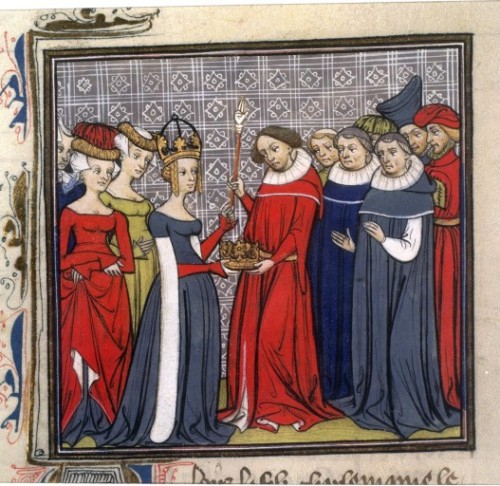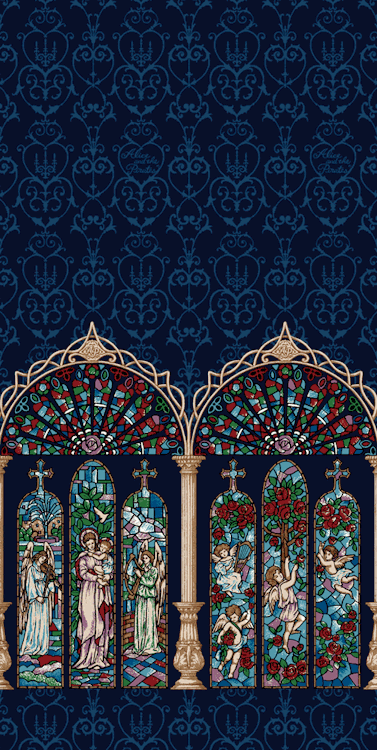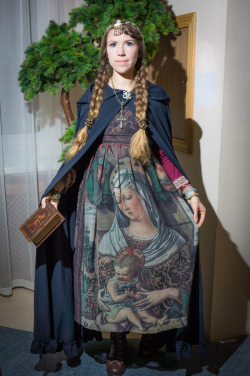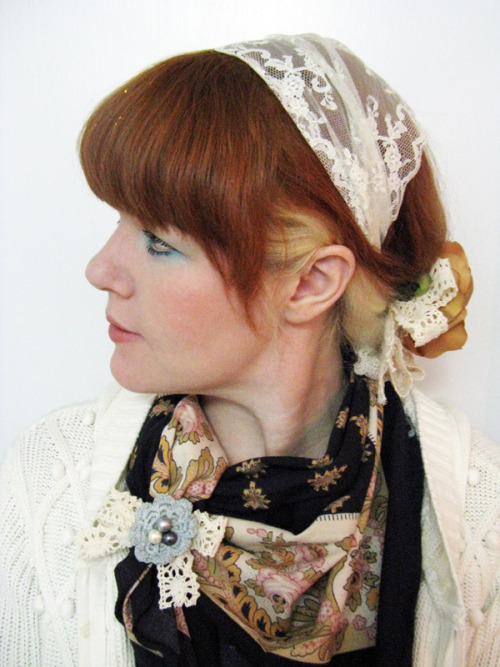 |
| Louis II le Bègue receives the Regalia. France, 14th Century illustration of an event from the 800s |
The middle ages are a fascinating period, not the least of which because of the way fashion worked in society. Fashion was a way of communicating class, and its regulation was a way of dividing class.
In terms of time period, this post is going to focus on the style of the high and late middle ages (about 1000 to 1500). It’s a broad time period, I know, but information is more limited when it comes to the medieval world so this can’t be as precise as studies of more recent fashion.
And, really, medieval inspiration will end up a fair bit looser than other inspiration simply because the styles are very different. My philosophy, though, is that you need to start by pleasing yourself with a coord, whether people recognize the inspiration or not.
Color
Color was just one of the ways that the nobility of the middle ages displayed their wealth, and it's a surprisingly subtle way to reference the time period. Because dark colors and bright colors took longer to dye than muted shades, these fabrics were much more expensive and more sought after by those looking to wear their status literally on their sleeves.
Rich colorss would include purples, deep reds, and blue-greens. Yellow, olive green, sky blue, brick red, and other vibrant colors were also common, often combined in one outfit. Black was another color that was sought after because of how complex a process dying it was (I will save you my lecture on the place of black silk in sumptuary laws; suffice it to say that wearing black has an interesting history).
 |
| An example of a medieval color palette |
While I know the idea of wearing fur makes some ladies uncomfortable, fur trim was very popular in the late medieval world. In terms of color, the most sought after furs during the time were:
- Ermine – white with black spots. Ermine is often seen at the edges of royal robes.
- Sable – very dark brown, almost black
- Miniver – white. Miniver, in terms of animal, is a pure white ermine.
Fur as a fashion statement began in the twelfth century. At this point, rather than just a practical addition for warmth, fur began to be used as decorative trim and lining in the clothing of the nobility. You can make a nod to this by wearing a fur-trimmed cape, fur-trimmed gloves, or even a fur detached collar.
The Cote and the Houppelande
There were really two different silhouettes that were popular in the medieval period: tight in the bodice and very, very loose.
Fitted dresses, called cotes among their many names, are your most absolutely basic dress. Featuring straight sleeves and a fitted bodice, these dresses are very simple and, as a result, some of the most difficult to use with Lolita. The straight sleeves in particular are difficult to find.
 |
| Unfortunate, because some of these gowns are stunning. |
The houppelande is rather the opposite of the cote and surcote in terms of fit: it’s very, very loose. Full from the shoulders down and sometimes belted under the bust, the houppelande rose to prominence in the fifteenth century. You can get the look of the houppelande by wearing a high waisted dress like this one or a dress with essentially no defined waistline like this one.
Prints and Motifs
Heraldic imagery and royal crests are one option for medieval motifs that is fairly prevalent in lolita. Look for unicorns, crowns, fleur du lis, lions, shields, etc. Brands have come out with a few designs that work easily into this.
 |
| Metamorphose's Old Emblem |
 |
| Grazia Crown |
 |
| Belle Pierreries |
 |
| Gloria Beautiful Glassy Saint Mary by Alice and the Pirates |

Hats and Headdresses
Medieval fashion was often about the headwear, and there are a lot of different styles to consider. Unfortunately, many of them are bit ostentatious even for use with Lolita and some of them are just downright silly outside the context of medieval costuming. I will be focusing, therefore, on the stuff that you can use for your coords.
Children and younger ladies also wore circlets of various sorts. Wreaths of flowers and metal bands (also often paired with veils) would be worn by maidens. Beneath these the hair would either be worn long and loose or braided. Flower crowns, obviously, have been really big recently, so this one isn't a problem for Lolita at all.
Veils were very common throughout the middle ages, though style varied. Full veils are a little bit tricky to pull off, but they can look lovely when done right.
If you want to hearken back to the veiled looks of the middle ages without the full veil, I would recommend using a wide scarf to do something like this braided updo. The scarf will give you a slightly veiled look without a full veil.
 |
| Source |
For those who want to make a nod to the caps of the middle ages without the full conical hat, try a simple, low pillbox hat. This idea is ripped pretty much straight from the concept art for Disney’s Sleeping Beauty, but it’s an idea I definitely agree with.
.jpg) |
| Image Source: Disney's Sleeping Beauty 2002 Special Edition DVD |
A final good option would be a full crown, but I would save that for your fanciest outfits.
Want to know more?
If you want to know more about medieval clothing and the socioeconomic factors that influenced it (much more interesting than it sounds, I swear!), I’d highly recommend reading these books:
Norris, Herbert. Medieval Costume and Fashion. Mineola, NY: Dover Publications, Inc. (1999).If you want to adapt a medieval pattern (especially the houppelande), I'd highly suggest:
Piponnier, Françoise and Perrine Mane. Dress in the Middle Ages. New Haven, CT: Yale University Press (2000).
Sarah Thursfield. The Medieval Tailor's Assistant. Los Angeles, CA: Quite Specific Media Group, Ltd. (2001).Another really good resource is SCA's guide to the medieval color palette if you're interested in the historical use of color.







No comments:
Post a Comment